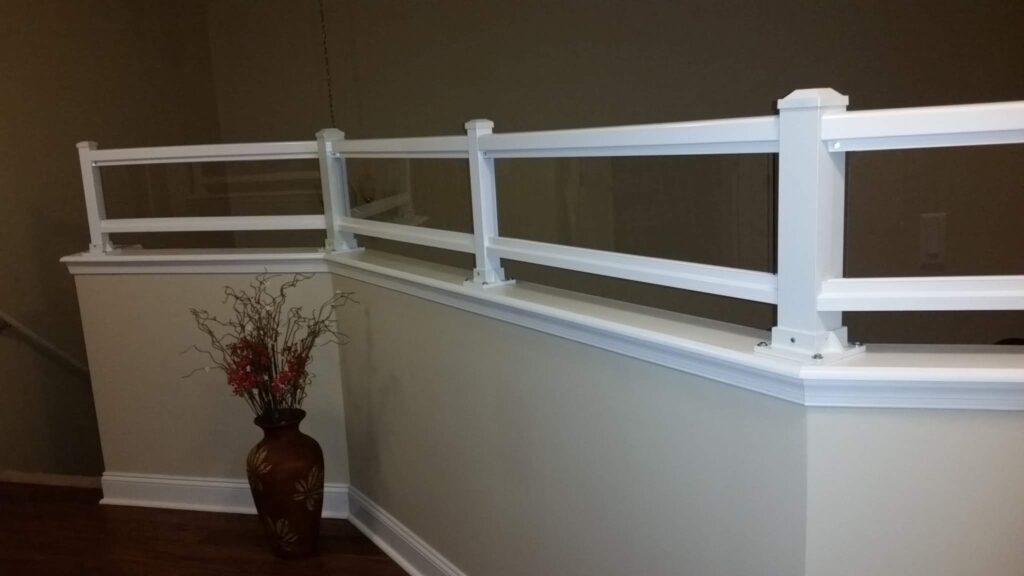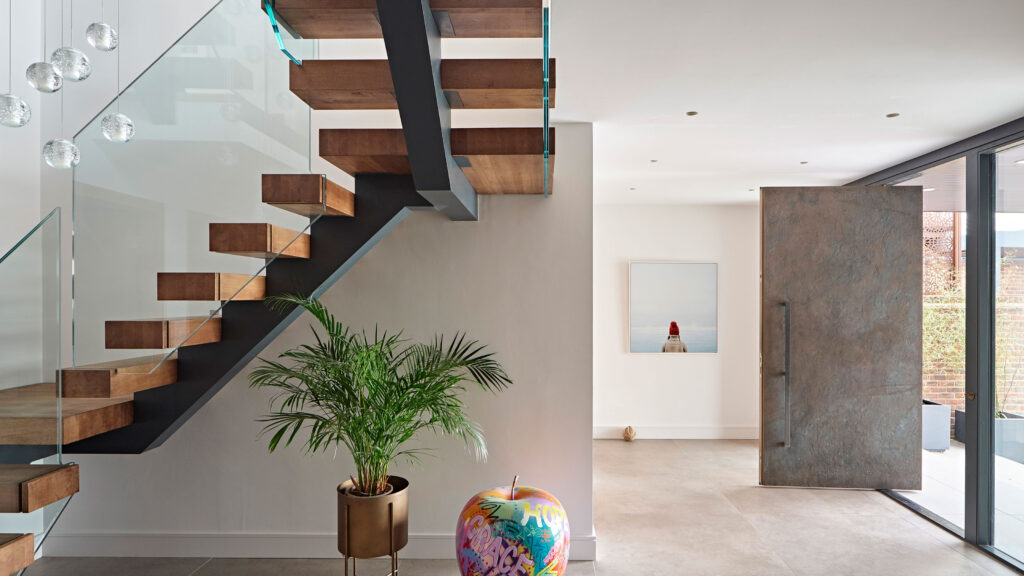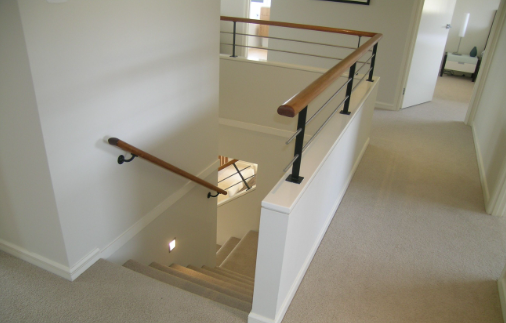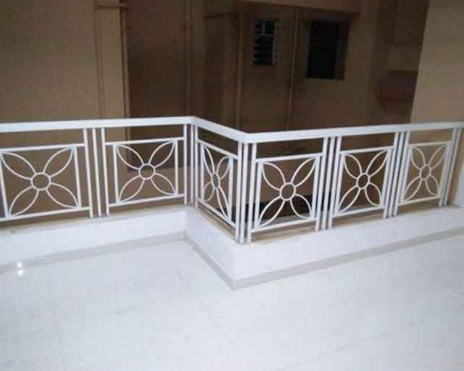As a homeowner, one of the most important decisions I had to make during the renovation process was whether to install a half wall or a railing. Both options have their pros and cons, and it was up to me to weigh them and decide which one would be the best fit for my home.
Whether to use a half wall or a railing in a specific location in your home depends on various factors, including your design preferences, the intended function of the barrier, safety considerations, and the overall aesthetics of the space.
Half Wall vs Railing: What’s the Difference?
Before I share my experience with choosing between a half wall and a railing, let’s take a moment to understand what they are.
A half wall is a low-height wall that is typically used to separate two areas in a room or to create a boundary between a staircase and a landing. It is usually made of brick, stone, or drywall and can be decorated with various finishes to match the decor of the room.
On the other hand, a railing is a series of vertical posts that are connected by horizontal bars or cables. Railings are commonly used for staircases, balconies, decks, and other areas that require a safety barrier.
Both half walls and railings have their unique features that make them suitable for different situations. In the following sections, I will discuss some of the factors that influenced my decision when choosing between these two options.

Comparison Table
To summarize the factors that influenced my decision, I have created a comparison table below:
| Factor | Half Wall | Railing |
| Cost | More expensive | More affordable |
| Style and Design | Classic and traditional | Modern and contemporary |
| Safety | Provides a sense of security | Meets safety standards and offers a clear view |
| Maintenance | Requires more maintenance | Requires low maintenance |
| Installation | Requires more time and effort | Requires minimal time and effort |
Let’s now look at these differences in detail.
1. Cost
One of the primary factors that influenced my decision was the cost. Half walls are generally more expensive than railings, as they require more material and labor to construct. In my case, I wanted to renovate my staircase and landing, and a half wall would have added a significant cost to the project.
However, railings are more affordable and easy to install. They can be made of various materials such as wood, metal, or glass, and can be customized to match the style of your home. I ultimately chose a railing for my staircase and landing because it fit within my budget and offered a sleek and modern look.

2. Style and Design
Another factor that influenced my decision was the style and design of my home. I wanted to choose an option that would complement the overall look of my home and enhance its aesthetic appeal.
Half walls offer a classic and traditional look and can be decorated with various finishes such as tile, stone, or wood paneling. They also offer a sense of privacy and can be used to create a cozy and intimate space.
On the other hand, railings offer a modern and contemporary look that can be customized to match the style of your home. They can be made of various materials such as metal or glass, and can be designed to create an open and airy feel.
In my case, I chose a railing because it offered a sleek and modern look that complemented the style of my home.
3. Safety
Safety was another important factor that influenced my decision. As a homeowner, I wanted to ensure that my family and guests were safe when using the staircase and landing.
Half walls offer a sense of security and can prevent people from accidentally falling over the edge. However, they can also create a blind spot and obstruct the view of the surrounding area, which can be dangerous in some situations.
Railings, on the other hand, offer a clear view of the surrounding area and can prevent people from accidentally falling over the edge. They are also required by building codes in many areas and are designed to meet strict safety standards.
In my case, I chose a railing because it offered a clear view of the surrounding area and met the safety standards required by building codes.
4. Maintenance
Maintenance was another important factor that influenced my decision. As a homeowner, I wanted to choose an option that was easy to clean and maintain.
Half walls require more maintenance than railings, as they can accumulate dust and dirt over time. They also require periodic repairs, such as patching and repainting, to maintain their appearance and structural integrity.
Railings, on the other hand, are relatively easy to maintain. They can be cleaned with a simple soap and water solution and require minimal repairs over time.
In my case, I chose a railing because it offered low maintenance and was easy to clean and maintain.

5. Installation
The installation process was another factor that influenced my decision. As a homeowner, I wanted to choose an option that was easy to install and would not require a lot of time and effort.
Half walls require more time and effort to install than railings, as they require more material and labor. They also require more planning and coordination with the construction team to ensure that they are built to the right specifications.
Railings, on the other hand, are relatively easy to install. They can be installed in a matter of hours and require minimal planning and coordination with the construction team.
In my case, I chose a railing because it was easy to install and did not require a lot of time and effort.
Pros and Cons of Half Wall and Railing
Let’s now explore the advantages and disadvantages of both options:
Half Wall:
Advantages:
- Privacy: Half walls can provide a degree of privacy or separation between spaces while still allowing for some visual connection between them.
- Design Flexibility: They can be designed to match the style and decor of the room and can include features like built-in shelving or decorative elements.
- Sound Barrier: Depending on the materials used, half walls can help dampen sound transmission between areas.
- Safety: In some cases, a half wall may be safer than a railing, especially if it is positioned in a location where people might accidentally fall over a railing.
Disadvantages:
- Visual Division: Half walls create a more significant visual division between spaces compared to railings, which can make a room feel smaller and less open.
- Less Light: Half walls can block the flow of natural light between areas, potentially making spaces feel darker.
Railing:
Advantages:
- Openness: Railings provide an open and airy feel to a space, allowing for unobstructed views and light flow between areas.
- Safety: Railings are designed with safety in mind, especially in areas where there’s a risk of falling, such as stairs or balconies.
- Contemporary Design: Railings often have a more modern and minimalist appearance, which can complement contemporary interior designs.
- Flexibility: Railings come in various materials, styles, and finishes, making it easy to find one that matches your design preferences.
Disadvantages:
- Less Privacy: Railings offer less privacy than half walls, which may not be suitable if you want clear separation between spaces.
- Limited Design Features: Railings are typically straightforward in design and may not include additional features like shelving or decorative elements.
- Sound Transmission: They do not provide as much sound insulation as half walls, which could be a consideration in some situations.
In summary, neither half walls nor railings are universally “better” than the other. Your choice should be based on the specific needs and goals of your space. If you prioritize privacy, sound insulation, or the incorporation of design features, a half wall may be a better choice. If you value openness, safety, and contemporary aesthetics, a railing may be more suitable. Ultimately, your decision should align with your overall design vision and the function of the barrier in your home.
The Verdict
Choosing between a half wall and a railing is a decision that should be based on various factors such as cost, style and design, safety, maintenance, and installation. Ultimately, I chose a railing for my staircase and landing because it fit within my budget, offered a sleek and modern look, met safety standards, required low maintenance, and was easy to install.
As a homeowner, it’s important to weigh the pros and cons of each option and choose the one that best fits your needs and preferences. I hope my personal experience and insights have been helpful in guiding you towards making the best decision for your home.

